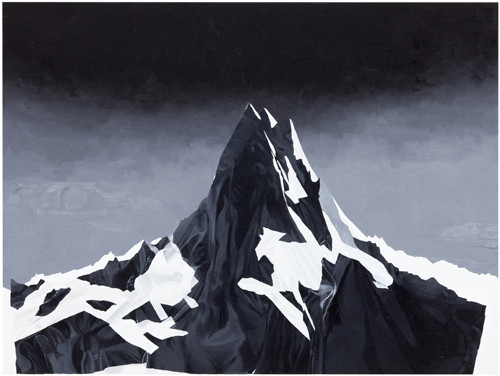Päivi Takala
06 Mar - 08 Apr 2012
PÄIVI TAKALA
Unmergeable
6 March - 8 April, 2012
The melting icebergs, uprooted trees and collapsed monuments of Päivi Takala's vanitas paintings allude to a lost landscape, the loss of species and forms, the threat of a disaster out of control and going beyond the human scale. The mountain themes bring to mind the sublime sphere of the Early Romantic experience of nature, in which the pleasure experienced before a landscape merged with despair – "wasted mountain, noble ruin" (Shaftesbury, The Moralists, III, 1709).
While Takala's cut, pasted, shredded and stuffed peaks could point to the melting of glaciers, they above all they leak like a sieve: the motif, the presentation is cut onto the base, through the pictorial surface. The landscape props resemble a cut stencil, a serigraphic screen. The landscape becomes a cliché, a printing block, a replicable reverse surface. The works also refer to developing photographs or the first frame of a film, the editing of film and montage (Paramount). The backdrop separates from the canvas base, the painting's curtains fall, the presentation flows beyond its bounds, and the subject disappears. The paintings Illusion, Figure and Portrait manifest the history of painting from the 19th to the 20th century, how the time-honoured genres of painting, such as portraiture and landscape are erased, the traditionL purpose of painting, the idea of the image as similarity and imitation is eroded through industrial techniques of replication. Masking tape, the painter's tool, the aid to clearly delimited perception, the support of illusion, comes off the background. The painter's working process is recorded on the tape as an adhesive surface for viewers, but the contours of the human figure hatch out of their shells, the message that is to be passed on disappears, like the obscure subject itself.
The Tatlin and Cross series bring to mind the utopias of modernism. The cast-iron concept of Tatlin Monument to the Third International melts and the black crosses referring to Malevich's painting hatch forth from their white background. Both the constructivists and the suprematists believed that painting would end by merging it with life, the planning of society and architecture. The purpose of art was to arrange, for example with the means of design, our shared living space, to outline a form for things shared, to create a concrete form for the community, a way of life. The tapes and adhesives that come off Takala's paintings disengage themselves from these "social plastics", from terminated projects with goals. Conversely, they ask whether art in the present can maintain any kind of critical position, leaving room for the unmergeable, the unblending.
Inkamaija Iitiä
Unmergeable
6 March - 8 April, 2012
The melting icebergs, uprooted trees and collapsed monuments of Päivi Takala's vanitas paintings allude to a lost landscape, the loss of species and forms, the threat of a disaster out of control and going beyond the human scale. The mountain themes bring to mind the sublime sphere of the Early Romantic experience of nature, in which the pleasure experienced before a landscape merged with despair – "wasted mountain, noble ruin" (Shaftesbury, The Moralists, III, 1709).
While Takala's cut, pasted, shredded and stuffed peaks could point to the melting of glaciers, they above all they leak like a sieve: the motif, the presentation is cut onto the base, through the pictorial surface. The landscape props resemble a cut stencil, a serigraphic screen. The landscape becomes a cliché, a printing block, a replicable reverse surface. The works also refer to developing photographs or the first frame of a film, the editing of film and montage (Paramount). The backdrop separates from the canvas base, the painting's curtains fall, the presentation flows beyond its bounds, and the subject disappears. The paintings Illusion, Figure and Portrait manifest the history of painting from the 19th to the 20th century, how the time-honoured genres of painting, such as portraiture and landscape are erased, the traditionL purpose of painting, the idea of the image as similarity and imitation is eroded through industrial techniques of replication. Masking tape, the painter's tool, the aid to clearly delimited perception, the support of illusion, comes off the background. The painter's working process is recorded on the tape as an adhesive surface for viewers, but the contours of the human figure hatch out of their shells, the message that is to be passed on disappears, like the obscure subject itself.
The Tatlin and Cross series bring to mind the utopias of modernism. The cast-iron concept of Tatlin Monument to the Third International melts and the black crosses referring to Malevich's painting hatch forth from their white background. Both the constructivists and the suprematists believed that painting would end by merging it with life, the planning of society and architecture. The purpose of art was to arrange, for example with the means of design, our shared living space, to outline a form for things shared, to create a concrete form for the community, a way of life. The tapes and adhesives that come off Takala's paintings disengage themselves from these "social plastics", from terminated projects with goals. Conversely, they ask whether art in the present can maintain any kind of critical position, leaving room for the unmergeable, the unblending.
Inkamaija Iitiä

